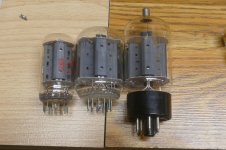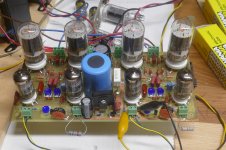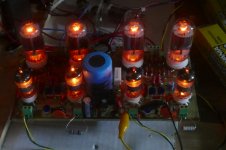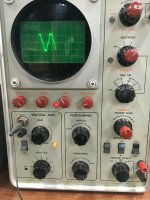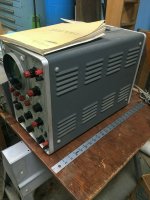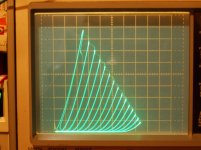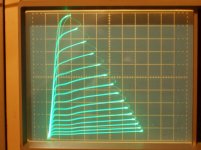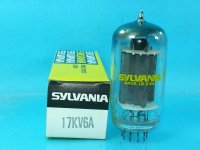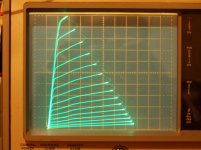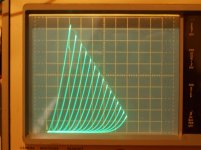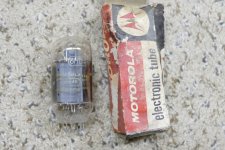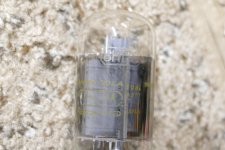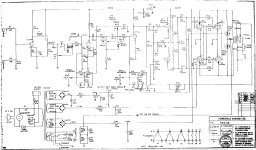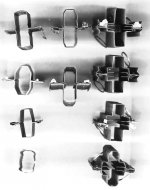Well $3 is the new $1.Those and most of the other Sweep tubes on it went out of stock in the first 6 months of the $1 list, like 10 years ago. Vacuumtubes.net started it, and ESRC copied it till recently.
Maybe we should call it the "Weep" list now. The 12/38HE7 with an approx. 15 Watt Sweep pent. was on the list till the end (when ESRC vanished last year). 25BQ6's too.
I bought some 12GE5 tubes back when they were on sale. Never found many people using them for PP but triode strapped they look a lot like a 2A3.
I've been wanting to make a higher power amp lately and these tubes certainly fit the bill. How well do you think a 4k load would work? Been thinking about pulling the trigger on a pair of these. TTG-KT88PP - Tube output transformer [4kOhm] 2xKT88 / 2x300B Push-pull or similar - Shop Toroidy.pl
I've been wanting to make a higher power amp lately and these tubes certainly fit the bill. How well do you think a 4k load would work? Been thinking about pulling the trigger on a pair of these. TTG-KT88PP - Tube output transformer [4kOhm] 2xKT88 / 2x300B Push-pull or similar - Shop Toroidy.pl
I would expect 4K P-P to work well with 17 or 18 Watt Sweep tubes. 3.3K works well with 24 or 28 Watt Sweep tubes. 2.5K to 2.7K for 30+ Watt P-P Sweeps.
P. Millett used 8K for his "Engineers Amp" with 6JN6 ( equiv. to 12GE5) but that was to get the output stage distortion low enough for the driver Harmonic dist. to cancel with it.
------------------
Yeah, seems like my grocery bill has done that since then.
P. Millett used 8K for his "Engineers Amp" with 6JN6 ( equiv. to 12GE5) but that was to get the output stage distortion low enough for the driver Harmonic dist. to cancel with it.
------------------
Well $3 is the new $1.
Yeah, seems like my grocery bill has done that since then.
Last edited:
And the winner is ..... 12GE5 (from the $1 tube list, 17.5 Watt tube)
The 6GE5 is a 6DQ6 that lost it's plate cap. Some specs are a little different, probably due to more modern materials, or just differences in measurements.
The 6GF5 is a 6GE5 with it's plate "wings" clipped so it will fit in a skinny bottle.
The 6GF5 was on ESRC's $1 list forever, despite me buying "all that he had" more than once, often for less than $1. I had them running at 80 watts per pair for a couple hours of continuous sine waves with nothing glowing.
When I was quite young I had created a guitar amp design that was basically a Fender Champ with a 6BQ6GT TV sweep tube in place of the 6V6 and a bit more B+. It rocked and was quite loud. Note that the 6BQ6 and the 6DQ6 have the same pinout as the usual 6V6 and 6L6 types except that the plate is connected to a cap on the top of the tube. Note, these are NOT electrically equivalent to any of the common audio tubes, but that didn't stop a 12 year old kid from making (and blowing up) guitar amps. 6V6 and 6L6 types were rare, and cost money, but 6BQ6's and 6DQ6's were free, from inside a discarded TV set, which were quite common in the early 60's.
Of course I didn't understand little things like bias or impedance, bit I never understood why the amp was quieter and tended st smoke when I plugged in the bigger 6DQ6 tube. Years later I would figure all that stuff out.
Now much later I have revisited some of those tubes from my youth, the old TV tubes, and the then dirt common 807's, which I never knew at time WERE 6L6GB's in disguise. I also found out by cracking open a few, then looking them up, that these 3 tubes contain exactly the same guts. The little ones just have smaller wings on their plates. The little guys ROCK too.....that board makes 75WPC!!!!
The little guy is a 6GF5's, the middle tube is a 6GE5's and the tall guy is a 6DQ6.
Attachments
Last edited:
I think I read where the 6GF5 was used in the TEK 555 scope power supply. Maybe -only- there too, not much demand I think. A Horiz. sweep for some tiny TV? My old Heathkit IO-14 scope had 6GE5 tubes in it for Volt. regulators.
Attachments
Last edited:
They were also found in small TV sets for a few years. I have found them in three different heights with the Zenith branded GE's being the shortest and RCA's the tallest. The amp in the above picture has Zenith branded GE's in the left channel, and regular GE's in the right. The right channel tubes are about 1/4 inch taller.
I worked in the calibration lab in a Motorola plant for 10 years. The TEK 504 and another similar scope that used a 6DQ6 in a vacuum tube SMPS. I used to have some 6DQ6's in my "crash cart" when I ran factory floor support in the early 70's. Swapping that tube always fixed the "my scope is getting dim" issues. By the late 70's all of those scopes had been swapped out for solid state Hitachi V-151's.
I worked in the calibration lab in a Motorola plant for 10 years. The TEK 504 and another similar scope that used a 6DQ6 in a vacuum tube SMPS. I used to have some 6DQ6's in my "crash cart" when I ran factory floor support in the early 70's. Swapping that tube always fixed the "my scope is getting dim" issues. By the late 70's all of those scopes had been swapped out for solid state Hitachi V-151's.
Last edited:
Here is a sleeper Sweep tube. The 17KV6A (Sylvania traced here)
It's rated at 28 Watts for HV regulator service (in TVs). The regulator description may have put some off to it for audio, but this is a very fine Sweep tube as well, most likely based on the 6KM6 Sweep tube. The data sheets for 6KM6 and 6KV6 (non -A) were identical.
Then the -A version came along with a higher plate Watt rating but lower Screen Watt rating. For regulator service, the screen current can be kept low and steady. The usual conversion factor for Sweeps is 4 plate Watts for every reduced Screen Watt.
So reverting that back to Sweep duty would put the 17KV6A at 22 Watts plate and 3.5 Watts screen. It has the same size plate as many 24 Watt Sweep tubes with a grid 1 cooler fin up top (similar to 6LG6A). It's a low screen current tube anyway, so maybe a 24 Watt rating makes OK sense for Sweep duty. 275 mA max DC, 950 mA peak (spec)
The main issue with this tube is the NOVAR socket. Hard to find good fitting real Novar sockets these days. Many Magnoval/Novar Chinese sockets are too loose on Novar pins, but a few do work. These tubes were sold years back on Antique Electronics Sales brochures for $2.30, but not so cheap lately. One thing I like about some versions of this tube (mainly Sylvania 17KV6 is the seal tip on top, looks Antique) Some other Novar tubes have a similar top seal, like 22JG6, 17JT6, 22JR6.
a) pentode 50V/div Horiz., 50mA/div Vert., -2V steps, 140V on grid 2
b) triode mode 50V/div Horiz., 50mA/div Vert., -6V steps (Mu 4 spec)
It's rated at 28 Watts for HV regulator service (in TVs). The regulator description may have put some off to it for audio, but this is a very fine Sweep tube as well, most likely based on the 6KM6 Sweep tube. The data sheets for 6KM6 and 6KV6 (non -A) were identical.
Then the -A version came along with a higher plate Watt rating but lower Screen Watt rating. For regulator service, the screen current can be kept low and steady. The usual conversion factor for Sweeps is 4 plate Watts for every reduced Screen Watt.
So reverting that back to Sweep duty would put the 17KV6A at 22 Watts plate and 3.5 Watts screen. It has the same size plate as many 24 Watt Sweep tubes with a grid 1 cooler fin up top (similar to 6LG6A). It's a low screen current tube anyway, so maybe a 24 Watt rating makes OK sense for Sweep duty. 275 mA max DC, 950 mA peak (spec)
The main issue with this tube is the NOVAR socket. Hard to find good fitting real Novar sockets these days. Many Magnoval/Novar Chinese sockets are too loose on Novar pins, but a few do work. These tubes were sold years back on Antique Electronics Sales brochures for $2.30, but not so cheap lately. One thing I like about some versions of this tube (mainly Sylvania 17KV6 is the seal tip on top, looks Antique) Some other Novar tubes have a similar top seal, like 22JG6, 17JT6, 22JR6.
a) pentode 50V/div Horiz., 50mA/div Vert., -2V steps, 140V on grid 2
b) triode mode 50V/div Horiz., 50mA/div Vert., -6V steps (Mu 4 spec)
Attachments
Last edited:
Here is a Raytheon 6HJ5 Sweep tube. These tubes mostly vanished after P. Millett's 50 Watt Monoblock came out, and are quite nice. I think George said he could get up to 125 Watts out of a pair of these. Seems to also be the biggest cap-less 24 Watt Sweep tube around. It's a Low screen current version of the 6DQ5. Similar to the 21/6LG6A too. I believe ALL the brands of 6HJ5 around (RCA, SYL, ...) were actually made by Raytheon. These tubes were selling for like $3 to $5 for a long while, until they mostly vanished. I suspect they were made for some Radar monitor deflection use.
a) pentode 50V/div Horiz., 50 mA/div Vert., -2V steps, 108V on grid 2
b) triode mode 50V/div Horiz., 50 mA/div Vert., -6V steps (Mu 4.2 spec)
------
When Davorin's odd "winged" 6DQ5 gets here for tracing, you can all decide which tube curves it most resembles.
a) pentode 50V/div Horiz., 50 mA/div Vert., -2V steps, 108V on grid 2
b) triode mode 50V/div Horiz., 50 mA/div Vert., -6V steps (Mu 4.2 spec)
------
When Davorin's odd "winged" 6DQ5 gets here for tracing, you can all decide which tube curves it most resembles.
Attachments
Last edited:
The 6HJ5 has a twin, the 6HD5, 21HD5 and 28HD5. It's the same tube except for minor pinout differences. The cathode is connected directly to G3 and pin 2 is left open on the 6HD5. Connect pins 2,4, and 10 together in your design and you can use either tube. Back when I was playing with Pete's big red board I bought a box full of 6HD5's from Stan for cheap since he had no record of ever selling any.
I have seen Raytheon and a Japanese version of the 6HD5. I have never seen the 21 or 28 volt version. Most of the 6HD5's I have are Motorola branded. They could have used it in their crappy TV sets, but I don't think it was ever used in two way radio stuff.
I have seen Raytheon and a Japanese version of the 6HD5. I have never seen the 21 or 28 volt version. Most of the 6HD5's I have are Motorola branded. They could have used it in their crappy TV sets, but I don't think it was ever used in two way radio stuff.
I think I have a few 6HD5s. But i don't recall any of 6HJ5 or 6HD5 looking like it was Japanese. What brand name is on these Japanese versions boxes?
I just found a Setchell-Carlson box, but the tube still says LYFA on it, which is the Raytheon plant location apparently.
Late Edit:
I just found a Motorola 6HD5 box and the tube IS different. Looks like it has JAPAN on it, although mostly rubbed off. The plate is gray instead of black. I'm going to curve trace it to see if there's any difference.
I just curve traced the Motorola (Japan) 6HD5 versus the Raytheon 6HJ5 tube and the only noticeable difference is the Motorola tube needs 122V on grid 2 to match the Raytheon tube with 108V on grid 2. Fairly close otherwise, just a small difference in the small screen current "dents".
I just found a Setchell-Carlson box, but the tube still says LYFA on it, which is the Raytheon plant location apparently.
Late Edit:
I just found a Motorola 6HD5 box and the tube IS different. Looks like it has JAPAN on it, although mostly rubbed off. The plate is gray instead of black. I'm going to curve trace it to see if there's any difference.
I just curve traced the Motorola (Japan) 6HD5 versus the Raytheon 6HJ5 tube and the only noticeable difference is the Motorola tube needs 122V on grid 2 to match the Raytheon tube with 108V on grid 2. Fairly close otherwise, just a small difference in the small screen current "dents".
Last edited:
Mine are Motorola, and match your description. The word "GOLDEN" on the tube indicates that it was intended for TV use. Motorola's first TV set was called the Golden View. That name resurfaced a few times, always associated with TV's.
The grey plate does look like a clone of a GE plate, and the word compactron is on the box, which is a GE trademark.
The grey plate does look like a clone of a GE plate, and the word compactron is on the box, which is a GE trademark.
Attachments
Yep, looks exactly like the Motorola tube I have here. Getter rings on the sides of the plate instead of up top like the Raytheon. I probably got it from Stan too. It even says "Made in Japan" on one side only of the box, duh... I missed that before.
I assume Setchell-Carlson made TVs too. I've found like 4 of their boxes for 6HJ5. But they seem to be the usual Raytheon tube inside with barely visible Setchell-Carlson printing on it.
I assume Setchell-Carlson made TVs too. I've found like 4 of their boxes for 6HJ5. But they seem to be the usual Raytheon tube inside with barely visible Setchell-Carlson printing on it.
Last edited:
I did some more rummaging thru my bins of TV Sweep tubes and found some more 26/6DQ5 tubes. So I'm posting some plate curves for them to compare with Davorin's odd "winged" 6DQ5 when it arrives. The Raytheon 6DQ5 has surprisingly small screen current wrinkles for a tube without Barks or Boxlets in the plate. Maybe it just has really good grid 1 and grid 2 qalignment?
All curves are 50V/div Horiz., and 50mA/div Vert.
a) Raytheon 6DQ5 pentode -2V steps, 110V on grid 2
b) Raytheon 6DQ5 triode mode -6V steps
c) Westinghouse (Japan) 26DQ5 pentode -2V steps, 110V on grid 2
d) Westinghouse (Japan) 26DQ5 in triode mode, -6V steps
e) a second Sylvania 6DQ5 pentode -2V steps, 110V on grid 2
f) the earlier Sylvania 6DQ5 pentode -2V steps, 110V on grid 2
g) GE 21LG6 pentode -2V steps, 100V on grid 2
h) Raytheon 6HJ5 pentode -2V steps, 108V on grid 2
All curves are 50V/div Horiz., and 50mA/div Vert.
a) Raytheon 6DQ5 pentode -2V steps, 110V on grid 2
b) Raytheon 6DQ5 triode mode -6V steps
c) Westinghouse (Japan) 26DQ5 pentode -2V steps, 110V on grid 2
d) Westinghouse (Japan) 26DQ5 in triode mode, -6V steps
e) a second Sylvania 6DQ5 pentode -2V steps, 110V on grid 2
f) the earlier Sylvania 6DQ5 pentode -2V steps, 110V on grid 2
g) GE 21LG6 pentode -2V steps, 100V on grid 2
h) Raytheon 6HJ5 pentode -2V steps, 108V on grid 2
Attachments
-
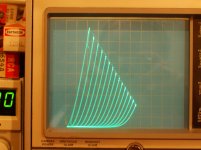 6DQ5_RAY_T_50V_50mA_6V.jpg637.3 KB · Views: 378
6DQ5_RAY_T_50V_50mA_6V.jpg637.3 KB · Views: 378 -
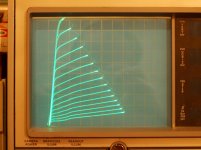 6DQ5_RAY_50V_50mA_2V_110V.jpg619.5 KB · Views: 351
6DQ5_RAY_50V_50mA_2V_110V.jpg619.5 KB · Views: 351 -
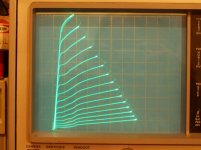 26DQ5_W_50V_50mA_2_110V.jpg642.1 KB · Views: 394
26DQ5_W_50V_50mA_2_110V.jpg642.1 KB · Views: 394 -
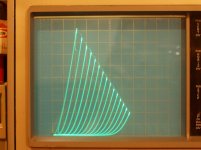 26DQ5_W_T_50V_50mA_6V.jpg637.4 KB · Views: 101
26DQ5_W_T_50V_50mA_6V.jpg637.4 KB · Views: 101 -
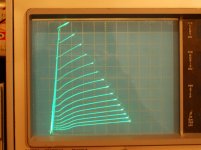 6DQ5_Syl2_50V_50mA_2V_110V.jpg623.9 KB · Views: 102
6DQ5_Syl2_50V_50mA_2V_110V.jpg623.9 KB · Views: 102 -
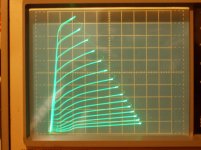 6DQ5_SYL_50V_50mA_2V_110V.jpg645.9 KB · Views: 107
6DQ5_SYL_50V_50mA_2V_110V.jpg645.9 KB · Views: 107 -
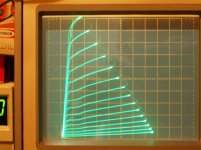 21LG6A_GE_50V_50mA_2Vsteps_100V.jpg663.2 KB · Views: 113
21LG6A_GE_50V_50mA_2Vsteps_100V.jpg663.2 KB · Views: 113 -
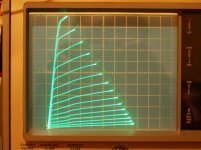 6HJ5_RAY_50_50_2_108.jpg653.3 KB · Views: 120
6HJ5_RAY_50_50_2_108.jpg653.3 KB · Views: 120
Last edited:
Here are a couple more Sweep tubes with the same size plate as the 6DQ5.
A Raytheon 6JS6A, which is also equiv. to 6HF5. No plate winglets or boxlets here.
And then a Sylvania 6JE6A/6LQ6.
The 6JE6A has the plate "winglets" and boxlets.
Also included the GE 21LG6A again, which has essentially the same curves as the 6JE6A, and has plate boxlets.
And the Syl 17KV6A which has the same size plate as all these, with plate boxlets. Pretty close curves to 21LG6A and 6JE6A too, except needs higher screen V.
50V/div Horiz., 50mA/div Vert. for all:
a) Ray 6JS6A pentode -2V steps, 97V on grid 2
b) Ray 6JS6A triode mode -8V steps
c) Syl 6JE6A pentode -2V steps, 102V on grid 2
d) Syl 6JE6A triode mode -8V steps
e) GE 21LG6A pentode -2V steps, 100V on grid 2
f) Syl 17KV6A pentode -2V steps, 140V on grid 2
A Raytheon 6JS6A, which is also equiv. to 6HF5. No plate winglets or boxlets here.
And then a Sylvania 6JE6A/6LQ6.
The 6JE6A has the plate "winglets" and boxlets.
Also included the GE 21LG6A again, which has essentially the same curves as the 6JE6A, and has plate boxlets.
And the Syl 17KV6A which has the same size plate as all these, with plate boxlets. Pretty close curves to 21LG6A and 6JE6A too, except needs higher screen V.
50V/div Horiz., 50mA/div Vert. for all:
a) Ray 6JS6A pentode -2V steps, 97V on grid 2
b) Ray 6JS6A triode mode -8V steps
c) Syl 6JE6A pentode -2V steps, 102V on grid 2
d) Syl 6JE6A triode mode -8V steps
e) GE 21LG6A pentode -2V steps, 100V on grid 2
f) Syl 17KV6A pentode -2V steps, 140V on grid 2
Attachments
-
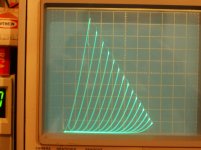 6JE6A_SYL_T_50V_50mA_8V.jpg652.1 KB · Views: 107
6JE6A_SYL_T_50V_50mA_8V.jpg652.1 KB · Views: 107 -
 6JE6A_SYL_50V_50mA_2V_102V.jpg637.5 KB · Views: 112
6JE6A_SYL_50V_50mA_2V_102V.jpg637.5 KB · Views: 112 -
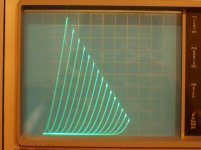 6JS6A_RAY_T_50V_50mA_8V.jpg627.4 KB · Views: 100
6JS6A_RAY_T_50V_50mA_8V.jpg627.4 KB · Views: 100 -
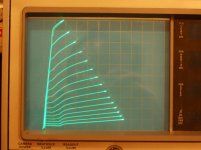 6JS6A_RAY_50V_50mA_2v_97V.jpg616.7 KB · Views: 100
6JS6A_RAY_50V_50mA_2v_97V.jpg616.7 KB · Views: 100 -
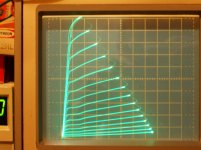 21LG6A_GE_50V_50mA_2Vsteps_100V.jpg663.2 KB · Views: 110
21LG6A_GE_50V_50mA_2Vsteps_100V.jpg663.2 KB · Views: 110 -
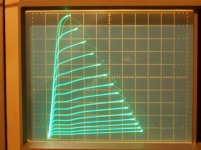 17KV6A_SYL_50_50_2_140.jpg672.1 KB · Views: 106
17KV6A_SYL_50_50_2_140.jpg672.1 KB · Views: 106
Last edited:
smoking-amp,
from the curves that you've been showing to us so far we can learn that sweep tubes with comparable plate structures aren't too different from each other.
Do you, per chance, also have 6JE6B's, 6MJ6's and 6KG6's that you may want to show?
Best regards!
from the curves that you've been showing to us so far we can learn that sweep tubes with comparable plate structures aren't too different from each other.
Do you, per chance, also have 6JE6B's, 6MJ6's and 6KG6's that you may want to show?
Best regards!
I have some 40KG6/PL509 tubes. The Sylvania and RCA ( all USA) ones have the plate "winglets" and "boxlets". The Raytheon, Sylvania, and Panasonic (all Japan, probably Matsushita) have mini-boxlets and grid 1 cooler fins (no winglets). I can run some curves for those tonight.
I don't have the 6JE6B or C version or the 6MJ6 or 6ME6 either. However, looking at the EIA/JEDEC sheets for these, and also the 6ME6, indicates these are all the same tube as 6JE6A except for some spec details and construction upgrades. Looks like 6JE6C and 6ME6 and 6MJ6 got the "winglets".
The Sylvania 6JE6A/6LQ6 I have seem to have all the stuff in the 6JE6C, so maybe later shipping just had the latest production tubes.
6JE6 RCA 1962 24 Watt
6JE6A RCA 1964 30 Watt with lower screen current
6JE6B GE 1967 30 Watt with lower temp operation using passivated beam plate material
6JE6C Sylvania 1968 gets the "special plate fin" or "winglet" and comments about being a "realistic" 30 Watt tube (these are all using a plate size that used to be 24 Watt) (and RCA complains about restricted operating conditions for an "up rated" tube )
6ME6 RCA 1972 special plate structure designed to minimize secondary electron emission from plate knee discontinuities, reduced heater power (dropped from 2.5A to 2.3A)
6MJ6 RCA 1973 reduced heater power (2.3 Amp) High reliability version of 6LQ6/6JE6C, top cap upgraded (no more loose caps) special plate structure to minimize secondary electron emission....
So looks like the original 30 Watt upgrade had some dissipation teething issues that got fixed, and the knee kinks got fixed, and then the heater power got reduced and the reliability increased. But they all have the same plate curves on the datasheets (except 6JE6B shows a small kink at very low current)
I don't have the 6JE6B or C version or the 6MJ6 or 6ME6 either. However, looking at the EIA/JEDEC sheets for these, and also the 6ME6, indicates these are all the same tube as 6JE6A except for some spec details and construction upgrades. Looks like 6JE6C and 6ME6 and 6MJ6 got the "winglets".
The Sylvania 6JE6A/6LQ6 I have seem to have all the stuff in the 6JE6C, so maybe later shipping just had the latest production tubes.
6JE6 RCA 1962 24 Watt
6JE6A RCA 1964 30 Watt with lower screen current
6JE6B GE 1967 30 Watt with lower temp operation using passivated beam plate material
6JE6C Sylvania 1968 gets the "special plate fin" or "winglet" and comments about being a "realistic" 30 Watt tube (these are all using a plate size that used to be 24 Watt) (and RCA complains about restricted operating conditions for an "up rated" tube )
6ME6 RCA 1972 special plate structure designed to minimize secondary electron emission from plate knee discontinuities, reduced heater power (dropped from 2.5A to 2.3A)
6MJ6 RCA 1973 reduced heater power (2.3 Amp) High reliability version of 6LQ6/6JE6C, top cap upgraded (no more loose caps) special plate structure to minimize secondary electron emission....
So looks like the original 30 Watt upgrade had some dissipation teething issues that got fixed, and the knee kinks got fixed, and then the heater power got reduced and the reliability increased. But they all have the same plate curves on the datasheets (except 6JE6B shows a small kink at very low current)
Last edited:
"winglets"
Is this what you mean.....
http://www.r-type.org/pics/aaa0021b.jpg
.
smoking-amp would you include curves for positive volts on g3 for 40KG6/PL509 tubes.To square those knees.
Ta very much!
Is this what you mean.....
http://www.r-type.org/pics/aaa0021b.jpg
.
smoking-amp would you include curves for positive volts on g3 for 40KG6/PL509 tubes.To square those knees.
Ta very much!
Last edited:
In the "Traynor YBA-3A" bass amp there are 4 pieces of 6KG6A in push-pull connection with Ua ~ 560V, Ug2 ~ 138V, Ug1-45V, and on Ug3-45 too! The excitation signal is fed normally to the G1, and I believe the amplifier certainly has more than 150W of output power.
Attachments
Davorin thanks .....interesting.Now what influence does a negatively charged g3 have on the PL509 characteristic curves?
Anyone know.....?
Anyone know.....?
Is this what you mean.....
No, those are grid cooler fins up top.
In the picture below, in the right side column, the top two plates have winglets on the edges. These help cool the Barkhausen fins inside.
The full right column has the plate "boxlets" with Barkhausen fins inside of them. These are what reduce secondary emission by grazing electron incidence on the Barkhausen plates and then the secondary electrons bounce around inside the box and get absorbed in the plate. This helps reduce secondaries getting back to the screen grid. Giving squarer plate curve knees with reduced kinks.
For 6JE6A and later versions of it, all had the boxlets with Barkhausen fins.
6JE6C, 6ME6 and 6MJ6 got the winglets in addition for better Bark. cooling.
Attachments
Last edited:
- Home
- Amplifiers
- Tubes / Valves
- Those Magnificent Television Tubes
